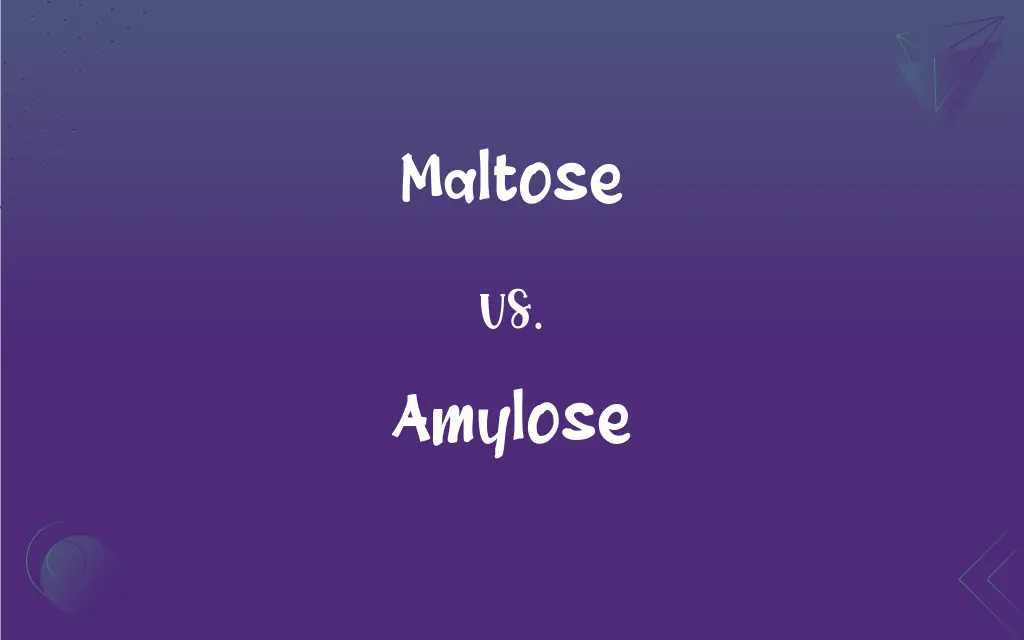Maltose vs. Amylose: What's the Difference?
Edited by Harlon Moss || By Janet White || Updated on November 11, 2023
Maltose is a disaccharide made of two glucose units, while amylose is a polysaccharide, a long chain of glucose units.

Key Differences
Maltose is a sugar formed from two glucose molecules linked together. Amylose, in contrast, is a much larger molecule, consisting of long chains of glucose units.
In maltose, the glucose units are joined by a specific type of glycosidic bond. Amylose, being a polysaccharide, has these glucose units linked in a way that forms a helical structure.
Maltose is known for its role in the digestion of starch and is produced during the breakdown of complex carbohydrates. Amylose is a major component of starch and contributes to the energy storage in plants.
Maltose is typically found in germinating grains and as a product of starch digestion. Amylose, on the other hand, is found in staple foods like rice, potatoes, and wheat.
The sweetness level of maltose is lower than that of common sugar (sucrose). Amylose does not have a sweet taste and is not used as a sweetener.
ADVERTISEMENT
Comparison Chart
Type of Sugar
Disaccharide
Polysaccharide
Composition
Two glucose units
Long chains of glucose units
Structure
Glucose units joined by a glycosidic bond
Glucose units in a helical structure
Role
Involved in starch digestion
Major component of starch, energy storage in plants
Occurrence
Found in germinating grains, starch digestion products
Found in rice, potatoes, wheat
ADVERTISEMENT
Taste
Less sweet than sucrose
Not sweet, not used as a sweetener
Maltose and Amylose Definitions
Maltose
A disaccharide composed of two glucose molecules.
Maltose is formed during the malting process in brewing.
Amylose
Composed of long chains of glucose molecules.
Amylose forms a helical structure due to its glucose arrangement.
Maltose
Sugar produced by the breakdown of starch.
Maltose levels increase in germinating seeds.
Amylose
Important for energy storage in plant cells.
Plants store glucose as amylose for energy.
Maltose
Involved in the fermentation process in beer production.
Yeast ferments maltose into alcohol during brewing.
Amylose
Contributes to the firm texture of starch-rich foods.
High amylose content in rice results in firmer grains.
Maltose
Less sweet compared to sucrose.
Maltose is preferred for its lower sweetness in some baking recipes.
Amylose
A polysaccharide and a key form of starch in plants.
Amylose is abundant in unripe bananas.
Maltose
A reducing sugar used in various food products.
Maltose is added to some candies for its moderate sweetness.
Amylose
Not sweet and not used as a sweetener.
Unlike maltose, amylose is not used for sweetness in foods.
Maltose
A white disaccharide, C12H22O11, formed during the digestion of starch. Also called malt sugar.
Amylose
A linear, unbranched polysaccharide that is one of the two main components, along with amylopectin, of starches.
Maltose
(carbohydrate) A disaccharide, C12H22O11 formed from the digestion of starch by amylase; is converted to glucose by maltase; it is an isomer of trehalose
Amylose
(carbohydrate) The soluble form of starch (the insoluble form being amylopectin) that is a linear polymer of glucose.
Maltose
A crystalline disaccharide (C12H22O11) formed from starch by the action of diastase of malt, and the amylolytic ferment of saliva and pancreatic juice; called also maltobiose and malt sugar. Chemically it is 4-O-
Amylose
One of the starch group (C6H10O5)n of the carbohydrates; as, starch, arabin, dextrin, cellulose, etc.
Maltose
A white crystalline sugar formed during the digestion of starches
FAQs
Does maltose contribute to the sweetness of foods?
Yes, but it is less sweet than sucrose.
Is maltose naturally occurring?
Yes, it occurs naturally in germinating grains and certain fruits.
Is maltose a simple sugar?
It's a disaccharide, so it's more complex than monosaccharides like glucose.
How is maltose used in brewing?
Maltose is fermented by yeast to produce alcohol in beer.
Can maltose cause allergic reactions?
Maltose allergies are rare but possible in some individuals.
What foods are high in amylose?
Foods like rice, potatoes, and unripe bananas are high in amylose.
Is maltose used in candy making?
Yes, for its moderate sweetness and moisture-retaining properties.
Can amylose be digested by humans?
Yes, amylose is digestible and a source of glucose.
Is amylose soluble in water?
It has limited solubility in water compared to other carbohydrates.
What role does amylose play in plants?
It's crucial for energy storage in plant cells.
Does amylose impact the texture of food?
Yes, high amylose content typically results in a firmer texture.
Does maltose have any health benefits?
It can be a source of energy, but like all sugars, should be consumed in moderation.
Does cooking affect amylose?
Cooking can alter the structure of amylose, impacting texture and digestibility.
Can amylose be broken down into simpler sugars?
Yes, enzymes like amylase can break it down into glucose.
Is amylose used in food processing?
Yes, particularly in products where a firm texture is desired.
Is maltose suitable for people with diabetes?
People with diabetes should monitor their maltose intake as it affects blood sugar.
Can amylose be extracted from plants?
Yes, it can be extracted from starch-rich plants for various uses.
Does maltose have a specific flavor?
It has a moderately sweet flavor, distinct from other sugars.
Is amylose a reducing sugar?
No, amylose is not classified as a reducing sugar.
How is maltose produced industrially?
It's produced by enzymatic hydrolysis of starch.
About Author
Written by
Janet WhiteJanet White has been an esteemed writer and blogger for Difference Wiki. Holding a Master's degree in Science and Medical Journalism from the prestigious Boston University, she has consistently demonstrated her expertise and passion for her field. When she's not immersed in her work, Janet relishes her time exercising, delving into a good book, and cherishing moments with friends and family.
Edited by
Harlon MossHarlon is a seasoned quality moderator and accomplished content writer for Difference Wiki. An alumnus of the prestigious University of California, he earned his degree in Computer Science. Leveraging his academic background, Harlon brings a meticulous and informed perspective to his work, ensuring content accuracy and excellence.































































